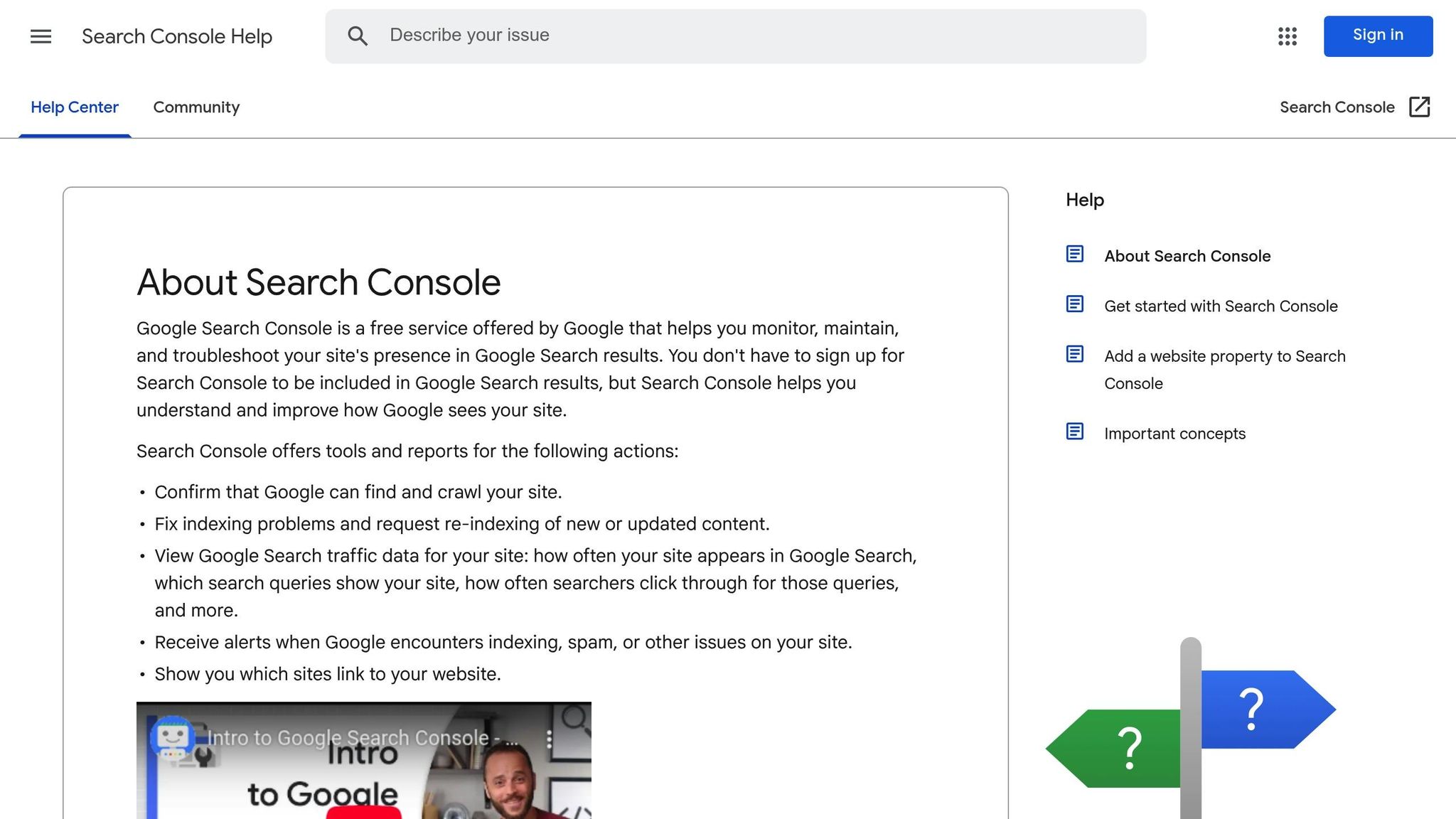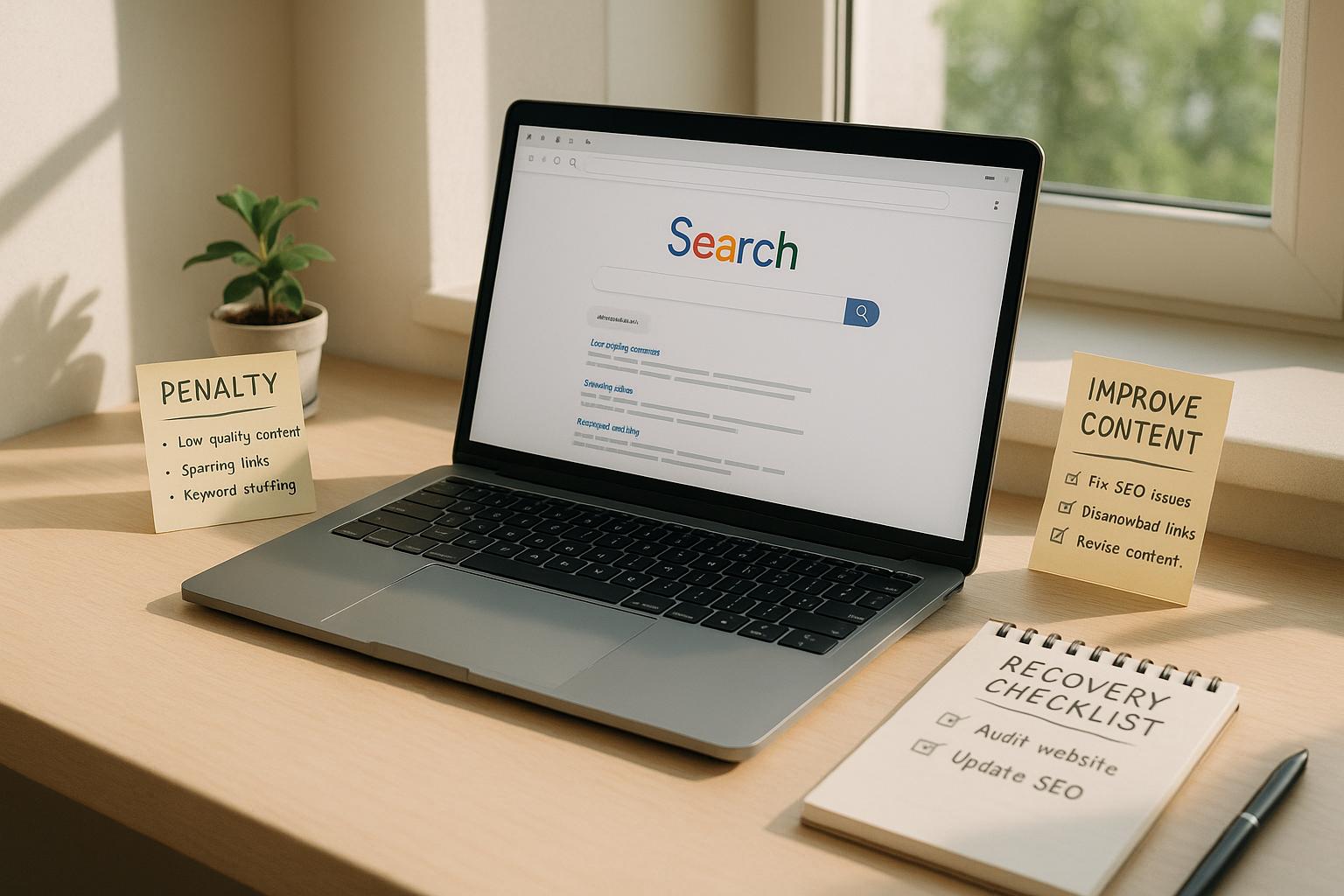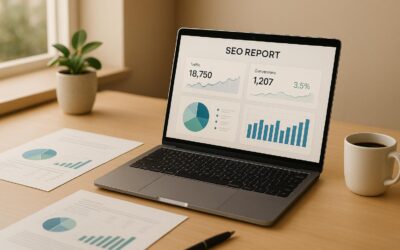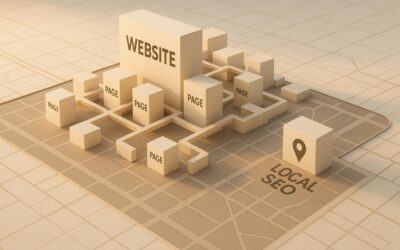Recovering from a Google algorithm penalty is challenging but achievable with the right steps. A penalty often means your website has violated Google’s guidelines, leading to reduced visibility, traffic loss, and revenue drops. Penalties come in two forms:
- Manual penalties: Issued by Google’s team and visible in Google Search Console.
- Algorithmic penalties: Triggered automatically by Google’s ranking systems, without direct notifications.
To recover, you must identify the penalty type, fix the root causes, and improve your site’s quality. Here’s how to start:
- Identify the penalty type:
- Check Google Search Console for manual action notifications.
- Use analytics tools to spot traffic drops tied to algorithm updates.
- Fix issues:
- Remove harmful backlinks, improve content quality, and address technical problems.
- For manual penalties, submit a reconsideration request after resolving issues.
- Monitor recovery:
- Track rankings, traffic, and user engagement metrics regularly.
Recovery can take months, so patience and consistent effort are key. Prevent future penalties by following Google’s guidelines, conducting regular audits, and avoiding risky SEO tactics.
SEO Recovery – Recover From Any Google Penalty
What Are Google Algorithm Penalties
Google algorithm penalties can drastically reduce your website’s visibility or even lead to deindexing if your site violates Google’s Search Essentials or Webmaster Guidelines. These penalties are Google’s way of addressing manipulative tactics or content that doesn’t meet their quality standards. Let’s explore the types of penalties and why they happen.
Manual vs. Algorithmic Penalties
Penalties come in two main forms: manual and algorithmic.
- Manual penalties are issued by Google’s human reviewers when they find your site breaking guidelines. If you receive one, you’ll see a notification in Google Search Console detailing the problem and the affected pages. This makes it easier to identify and address the issue.
- Algorithmic penalties, on the other hand, are automatic. Google’s ranking systems apply these penalties when they detect problems like poor-quality content or over-optimization. Unlike manual penalties, these don’t come with a notification. Instead, you’ll likely notice a drop in search rankings and organic traffic over time. Google’s advanced algorithms are now better than ever at spotting unhelpful or overly optimized content.
While manual penalties come with specific instructions for fixing the problem, algorithmic penalties require a thorough review of your site to uncover the root cause.
Why Penalties Happen
Penalties often occur when websites prioritize gaming the system over creating meaningful content for users. Some common triggers include:
- Content issues: Pages with thin or low-quality content that add little value.
- Unnatural backlinks: A pattern of low-quality or manipulative links pointing to your site.
- Over-optimization: Techniques that cater to search engine algorithms at the expense of user experience.
Understanding these triggers is crucial for developing a plan to recover and rebuild your site’s credibility.
How Penalties Impact Your Website
The effects of a penalty can be severe. A sharp drop in organic traffic and keyword rankings is common, making it harder for users to find your site. This loss of visibility often leads to reduced engagement and a decline in overall online performance. Essentially, penalties can undo all the hard work you’ve put into building your site’s presence, making recovery a top priority.
How to Identify Penalty Type and Scope
Understanding why a penalty occurred is just the first step. To recover effectively, you need to pinpoint the type of penalty and its scope. Without knowing whether you’re dealing with a manual or algorithmic penalty – or which pages are impacted – your recovery plan might miss the mark. Think of accurate identification as the foundation for fixing the issue.
To get started, gather relevant data, run some tests, and analyze the results. This process will help you determine if the penalty is manual or algorithmic and identify the affected areas.
Check Google Search Console for Manual Penalties

The first place to look for clues is Google Search Console (GSC). If your site has been hit with a manual penalty, Google will notify you directly through this platform, making it straightforward to identify.
Log in to GSC and navigate to the Manual Actions report. If there’s a penalty, you’ll see a notification explaining which pages are affected and why they violate Google’s spam policies. These details are essential for understanding what went wrong.
If you don’t find any manual action notifications in this section, double-check other GSC areas for related warnings. Manual penalties can target specific pages or even your entire site, preventing flagged pages from showing up in search results. If no notifications appear, you can likely rule out a manual penalty and shift your focus to algorithmic issues.
Find Algorithmic Penalties with Analytics Tools
Algorithmic penalties are trickier to detect because Google doesn’t send direct alerts when they occur. Instead, you’ll need to rely on analytics tools to uncover patterns and connect traffic drops to algorithm updates.
Start by reviewing your organic traffic in Google Analytics. Look for sudden declines in traffic, especially around the time of major Google algorithm updates. A sharp drop over a few days often signals an algorithmic penalty.
Next, cross-check these traffic dips with the dates of known Google updates. Updates like core algorithm changes or helpful content updates can penalize sites that don’t meet updated quality standards.
For deeper insights, use tools like SEMrush or Ahrefs to track which pages and keywords have lost rankings. A drastic drop – like falling from the first page to much lower positions – often points to an algorithmic issue.
Don’t forget to monitor metrics like click-through rates and impressions in Google Search Console. Even if your pages haven’t disappeared from the index, a penalty can push them down the rankings, leading to fewer clicks and impressions.
Once you’ve identified the problem, document the affected pages and the extent of the damage.
Record Affected URLs and Damage Level
Create a detailed record of all affected URLs, including their previous rankings, current rankings, and the traffic they’ve lost. A spreadsheet works well for this.
Here’s what to include for each URL:
- Previous ranking
- Current ranking
- Traffic loss
- Notes on the specific issue
To prioritize your recovery efforts, categorize the damage for each page. For example:
- Severe: Pages that dropped out of the top 50 search results.
- Moderate: Pages that fell from the first page to later pages.
- Minor: Pages with smaller ranking declines.
It’s also helpful to capture before-and-after screenshots of key metrics from Google Analytics and Search Console. These visuals can guide your recovery process and show the impact of your fixes.
Finally, focus on the most critical pages first – especially those that previously drove the most traffic or conversions. Pages with severe penalties should take top priority, as they offer the greatest potential for recovery.
How to Recover from Google Algorithm Penalties
Once you’ve identified the penalty type and assessed the damage, it’s time to roll up your sleeves and get to work on recovery. Whether you’re dealing with a manual or algorithmic penalty, the process requires a systematic approach, careful monitoring, and plenty of patience. Restoring your site’s trust with Google doesn’t happen overnight.
Fix Manual Penalties
Start with a thorough site audit. Review your backlink profile, content quality, technical setup, and any user-generated content to pinpoint violations and create a plan to address them.
Focus on tackling the most critical issues first. High-priority problems like cloaking or unnatural links should be resolved immediately. Then, move on to medium-priority concerns such as thin content or misused structured data, and finally address lower-priority issues like spammy user-generated content.
For unnatural link penalties, begin by identifying and removing toxic backlinks. Reach out to webmasters to request link removals and document your efforts. If removal isn’t an option, use Google’s Disavow Tool to neutralize harmful links. For example, Halifax Bank successfully recovered from a manual penalty by removing unnatural links and setting affiliate landing pages to 404 status. Similarly, Cashlady.com regained its standing after cleaning up spammy comments and unnatural links.
When it comes to content quality, focus on creating unique, valuable content. Merge competing pages, expand thin content with well-researched information, or eliminate low-value pages altogether. RapGenius, for instance, overcame its penalty by halting questionable link-building tactics and significantly improving the quality of its content, which helped restore its rankings and traffic.
Technical violations like cloaking or hidden scripts should be addressed promptly. Ensure that what users see matches what search engines crawl. For issues involving structured data misuse, remove misleading markup, follow Google’s schema guidelines, and verify the updates using Google’s Rich Results Test tool.
Once you’ve resolved all issues, draft a reconsideration request. Be transparent about the problems, explain the corrective actions you’ve taken, provide supporting documentation, and outline your commitment to maintaining compliance in the future. Submit your request through Google Search Console. While waiting for a response – which can take several weeks – continue maintaining your improvements.
If your site isn’t dealing with a manual penalty, it’s time to shift your focus to algorithmic issues.
Fix Algorithmic Penalties
Using insights from your audit, work on improving content quality and technical SEO. Recovery from algorithmic penalties often takes longer – sometimes six months or more – so patience is key.
Start by researching the specific algorithm update that impacted your site. Understand its focus and align your fixes accordingly. Staying informed about Google’s algorithm changes will help you tailor your recovery strategy.
Improve content quality by addressing common pitfalls like keyword stuffing, off-topic content, filler material, or mismatched search intent. If your site features AI-generated content that lacks real value, consider rewriting or removing it. For pages with low traffic or poor quality, you can either enhance their content to meet current search intent or remove them using 404 status codes or 301 redirects.
Strengthen E-E-A-T (Experience, Expertise, Authoritativeness, Trustworthiness) signals. Add author bylines and detailed bios, showcase your business information, and back up claims with credible sources or firsthand experience. This is especially critical for "Your Money or Your Life" (YMYL) sites that cover sensitive topics like health or finance.
Address technical SEO issues by analyzing crawl activity through log file audits. Look for shifts in crawl patterns or wasted crawl budget on low-value pages. Resolve Core Web Vitals issues, fix broken internal links, and ensure your site architecture supports efficient crawling and indexing.
Keep in mind that links naturally decay over time – about two-thirds disappear within nine years, and this figure rises to 75% when factoring in temporary errors and discovery issues. This natural link loss can amplify the effects of algorithmic penalties, making it essential to clean up and rebuild your link profile.
Track Recovery Progress
After implementing fixes, monitoring your progress is crucial. Recovery trends often take weeks or months to emerge, so consistent tracking is essential.
Use Google Search Console and Analytics to monitor recovery. Check the Manual Actions report for updates on penalties. For algorithmic penalties, keep an eye on metrics like rankings, click-through rates (CTR), and impressions to track improvements.
Set up automated alerts for significant changes in rankings or traffic using reliable SEO tools. Weekly reports can help you track ranking, traffic, and engagement metrics.
Recovery timelines vary. Manual penalties can sometimes be lifted within days of a successful reconsideration request. Algorithmic penalties, however, often require three to six months – or even longer – for noticeable recovery. Some sites may not fully regain their previous rankings, underscoring the importance of preventive measures.
In addition to rankings and traffic, monitor user engagement metrics like bounce rate, time on page, and conversion rates. These indicators contribute to long-term stability and can provide insights into your site’s overall health.
For advanced recovery tracking, tools like SearchX can provide valuable insights into your progress.
How to Prevent Future Penalties
Recovering from a penalty is just the beginning. To ensure long-term growth, it’s crucial to stick to best practices and build systems that keep your site compliant while delivering value to users.
Follow Google Guidelines
Stay updated with Google’s official resources. The Google Search Essentials and Quality Rater Guidelines are your go-to documents for understanding what Google prioritizes. Since these guidelines are updated regularly, make it a habit to review them every few months. Pay close attention to the Webmaster Guidelines, which clearly outline practices to avoid.
Perform regular content audits. Every three to six months, assess your site’s content for freshness, accuracy, and relevance. Remove outdated pages, improve underperforming ones, and combine duplicate content where necessary. Focus on maintaining E-E-A-T signals – Experience, Expertise, Authoritativeness, and Trustworthiness – especially if your site covers YMYL (Your Money or Your Life) topics like health or finance.
Keep an eye on your backlink profile. Toxic links can appear at any time, whether from negative SEO attacks or natural link decay. Set up monthly alerts to catch unusual spikes in backlinks and investigate promptly. Document your link-building efforts thoroughly to avoid unintentionally engaging in risky practices.
Maintain technical SEO health. Conduct site audits regularly to identify and fix issues like crawl errors, broken links, duplicate content, and Core Web Vitals problems. Addressing these technical issues early prevents them from escalating into bigger problems that could hurt rankings or user experience.
By combining these practices with reliable monitoring tools, you’ll stay ahead of potential compliance issues.
Use Tools to Monitor Your Site
Leverage Google Search Console (GSC) and automated alerts. Set up email notifications for critical problems to catch them early. Use the Performance report to track ranking changes and spot algorithmic impacts before they escalate.
Invest in reliable SEO tools. Automated alerts can help you identify significant ranking drops, traffic declines, or unusual crawl patterns. Weekly reports should monitor key metrics like organic traffic, keyword rankings, click-through rates, and Core Web Vitals performance.
Analyze log files. Log file analysis offers insights into how search engines interact with your site. Use it to track crawl frequency, identify wasted crawl budget, and detect unusual bot behavior. This data can be essential when diagnosing potential algorithm issues.
Monitor user engagement metrics. Go beyond traditional SEO indicators by tracking bounce rates, time on page, conversion rates, and user feedback. These metrics reveal how well your content meets user expectations and can highlight areas for improvement before they become liabilities.
Platforms like SearchX provide integrated tools that simplify penalty prevention and offer detailed insights into your site’s overall health and compliance.
Avoid Risky SEO Tactics
Even with strong monitoring and adherence to guidelines, avoiding harmful practices is critical to staying penalty-free.
Steer clear of black-hat techniques. Avoid link schemes, keyword stuffing, and over-optimization that prioritize search engines over users. Focus instead on earning links naturally through high-quality content and authentic partnerships. Google’s algorithms are increasingly adept at spotting manipulative tactics.
Be cautious with AI-generated content. While AI tools can be helpful, publishing large amounts of low-quality, machine-generated content without proper review can lead to quality-related penalties. Always edit and enhance AI-generated content to ensure it provides real value to users.
Don’t manipulate user-generated content. While user reviews and comments can enhance your site, inflating these artificially or neglecting to moderate spam can cause quality issues. Use moderation systems to maintain authenticity and encourage genuine user interaction.
The best way to prevent penalties is to combine proactive monitoring with a commitment to creating user-first content. By embedding these practices into your routine, you’ll not only safeguard against penalties but also build a solid foundation for sustainable growth in organic search.
Conclusion: Key Takeaways for Recovery and Growth
The first step toward recovery is understanding the type of penalty your site is facing. Manual penalties are flagged in Search Console, making them easier to identify, while algorithmic issues require a deeper dive into your site’s performance and data. Recovery hinges on accurate diagnosis, implementing specific fixes, and ensuring ongoing prevention.
Acting quickly is key to speeding up recovery. Manual penalties come with clear instructions for resolution, while algorithmic penalties demand more thorough analysis and adjustments. Be prepared to wait – recovery can take weeks or even months to show results. However, this effort sets the stage for long-term compliance and stability.
But recovery is just one piece of the puzzle. Sustained success calls for vigilance. Regular site audits and maintaining high standards for content quality and user experience are essential. Websites that thrive treat penalty prevention as a continuous effort, not a one-time task.
It’s worth noting that penalties, though frustrating, can serve as valuable lessons. They push you to scrutinize your SEO strategies and refine your processes. Often, the improvements made after addressing a penalty lead to stronger, more sustainable growth.
As Google’s algorithms evolve, the focus on user-first content, technical precision, and ethical SEO practices becomes even more critical. This mindset not only helps you recover from current penalties but also shields your site from future risks. By shifting from reactive fixes to proactive strategies, you can turn penalty recovery into a long-term growth opportunity for your website.
FAQs
How can I tell if my website has a manual or algorithmic Google penalty?
When Google applies a manual penalty to your site, it’s the result of an actual person reviewing your content and flagging issues. You can find out if this has happened by checking the ‘Manual Actions’ section in your Google Search Console. If your site is penalized, Google will outline the problem and provide guidance on how to fix it.
An algorithmic penalty, however, is entirely automated. These penalties are triggered when Google’s algorithms detect things like spammy behavior, poor-quality content, or other guideline violations. Unlike manual penalties, they won’t show up in your Search Console. Instead, you’ll need to watch for red flags like a sudden drop in traffic and compare those changes to recent Google algorithm updates. Keeping an eye on your analytics and staying up to date with Google’s changes can help you spot and address these penalties faster.
How can I avoid getting penalized by Google’s algorithm in the future?
To steer clear of potential Google algorithm penalties, prioritize crafting original, well-researched content that follows Google’s guidelines. Your content should reflect expertise, authority, and trustworthiness (E-A-T) to build credibility with both users and search engines. When it comes to backlinks, keep your profile natural by steering clear of manipulative tactics like link schemes.
It’s also essential to routinely check your site for technical issues. Fix broken links, improve slow-loading pages, and update outdated security protocols to ensure everything runs smoothly. Staying up-to-date with Google’s algorithm changes and making timely adjustments to your website will help you maintain compliance. Regular monitoring and upkeep are crucial for safeguarding your rankings and preserving your traffic over the long haul.
How long does it take to recover from a Google algorithm penalty, and what factors affect the timeline?
The time it takes to bounce back from a Google algorithm penalty can vary widely, depending on the type and severity of the issue. Minor problems might be resolved in just a few weeks, but more serious penalties could drag on for several months – or even longer than a year – before you see full recovery.
Several factors play a role in how quickly you can recover. These include the severity of the violations, how promptly you take corrective actions, and when Google’s algorithm updates occur. If you’re dealing with a manual penalty, you’ll likely need to submit a reconsideration request, which can take weeks or months for Google to review. For algorithmic penalties, recovery hinges on improving your site and waiting for Google to re-crawl and reassess your updates.
To speed up the process, focus on tackling the root cause of the penalty. This might mean cleaning up low-quality content, removing spammy backlinks, or addressing technical SEO issues. Recovery requires steady effort and patience, but with the right improvements, you can work your way back to better rankings and traffic.




